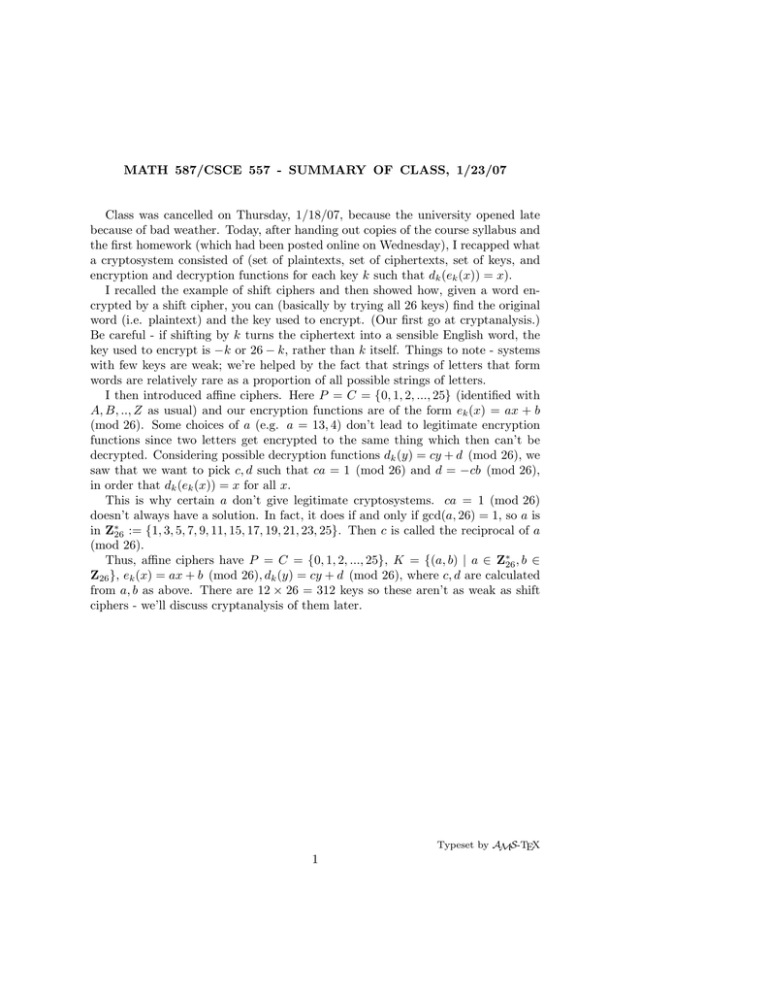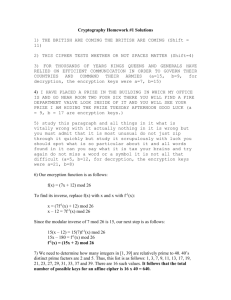MATH 587/CSCE 557 - SUMMARY OF CLASS, 1/23/07 Class was
advertisement

MATH 587/CSCE 557 - SUMMARY OF CLASS, 1/23/07
Class was cancelled on Thursday, 1/18/07, because the university opened late
because of bad weather. Today, after handing out copies of the course syllabus and
the first homework (which had been posted online on Wednesday), I recapped what
a cryptosystem consisted of (set of plaintexts, set of ciphertexts, set of keys, and
encryption and decryption functions for each key k such that dk (ek (x)) = x).
I recalled the example of shift ciphers and then showed how, given a word encrypted by a shift cipher, you can (basically by trying all 26 keys) find the original
word (i.e. plaintext) and the key used to encrypt. (Our first go at cryptanalysis.)
Be careful - if shifting by k turns the ciphertext into a sensible English word, the
key used to encrypt is −k or 26 − k, rather than k itself. Things to note - systems
with few keys are weak; we’re helped by the fact that strings of letters that form
words are relatively rare as a proportion of all possible strings of letters.
I then introduced affine ciphers. Here P = C = {0, 1, 2, ..., 25} (identified with
A, B, .., Z as usual) and our encryption functions are of the form ek (x) = ax + b
(mod 26). Some choices of a (e.g. a = 13, 4) don’t lead to legitimate encryption
functions since two letters get encrypted to the same thing which then can’t be
decrypted. Considering possible decryption functions dk (y) = cy + d (mod 26), we
saw that we want to pick c, d such that ca = 1 (mod 26) and d = −cb (mod 26),
in order that dk (ek (x)) = x for all x.
This is why certain a don’t give legitimate cryptosystems. ca = 1 (mod 26)
doesn’t always have a solution. In fact, it does if and only if gcd(a, 26) = 1, so a is
in Z∗26 := {1, 3, 5, 7, 9, 11, 15, 17, 19, 21, 23, 25}. Then c is called the reciprocal of a
(mod 26).
Thus, affine ciphers have P = C = {0, 1, 2, ..., 25}, K = {(a, b) | a ∈ Z∗26 , b ∈
Z26 }, ek (x) = ax + b (mod 26), dk (y) = cy + d (mod 26), where c, d are calculated
from a, b as above. There are 12 × 26 = 312 keys so these aren’t as weak as shift
ciphers - we’ll discuss cryptanalysis of them later.
Typeset by AMS-TEX
1







